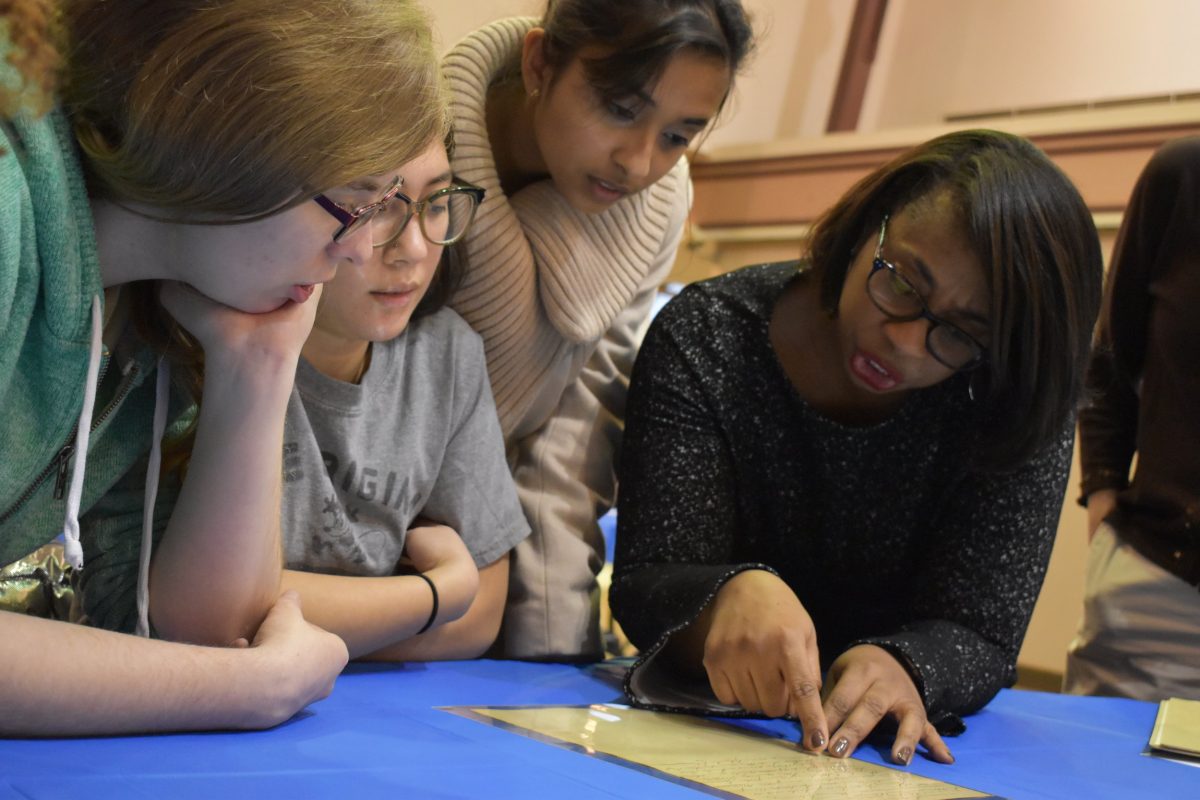Event speaker and coordinator Dr. Katrina Sims examines a receipt from of sale of an indentured servant in 1779 with students on the 10th floor of the library.
Real documents dating back to the 18th century detailing “the black experience” on Long Island were featured at the Hofstra Honors College “Friday Forum” this past Friday, Feb. 23 on the 10th floor of The Joan and Donald E. Axinn Library. The event was held in honor of Black History Month.
In the words of the speaker and professor of history, Dr. Katrina Sims, the event painted an image of the “black experience from the transatlantic slave trade to today.” It brought the history of the black experience to the streets of Long Island, and many were surprised to find that it happened right here too.
Vimala Pasupathi, an English professor and associate dean of the Honors College, helped organize the event. She described herself as an “archive snob,” and was very surprised to find that Hofstra’s Special Collections and the Schomburg Center for Research in Black Culture had many riveting documents and artifacts, right here on Long Island.
“Last year I saw the collection for the first time, and I was really moved by it,” Pasupathi said. “I had never seen a slave receipt before, and I didn’t really expect to encounter one at Hofstra.”
Pasupathi explained that since New York is in the north, people in the state seem to have a preconceived notion about the ‘North vs. South’ idea. “You don’t really think about the place you are every day having this history, especially in somewhere like New York,” Pasupathi said.
Students were just as surprised to be presented with real documents from eras of slavery and segregation here on Long Island that were so well preserved. Kyla Garcia, an undeclared freshman, agreed with this statement from Pasupathi. “Whether you’re from Long Island or not, you need to understand the history that makes up the town that you live in. It’s just really eye-opening, and I think everyone needs to be aware of that,” Garcia said.
Jake Haney, a sophomore civil engineering major, found the event and archives “humbling,” especially the document that was an 1828 receipt for a 7-year-old boy sold to be an indentured servant.
Haney hopes that knowing information like this and being exposed to such material will “inspire change for the better,” not only among Hofstra students.
“It’s a step towards … increasing black consciousness,” said Maasai Jones, a sophomore English major. Even during Black History Month, it can, at times, be forgotten just how much history exists. Many students feel that it’s really something people should be aware of.
After the initial presentation, Sims went around and helped students and faculty decipher the documents that were written in cursive and featured language that may be outdated today. Her enthusiasm for the topics drew students in, gathering a small crowd around the artifacts and papers as she went through them. The documents could be, she said, “claims for estate, punishment for crimes, [they] could be, like I mentioned before, a fugitive slave document, it just depends.” Sims was eager to answer questions, and during the presentation actively sought to involve the audience, connecting everyone in the room to what was being said.
“It gives them a better understanding … it lets them know the facts, what actually happened,” said Kiara Burrell, a freshman neuroscience major. While the documents were passed around, coated in protective coverings in order to maintain them, food and beverages were served, but not to be brought near the artifacts.
The items presented in this event were from the Hofstra Special Collections Library, but similar ones can be found in places like the Schomburg Center.
With black culture being a prominent topic in the current societal conversation, it is important to remember and reflect on the history behind it.
In this forum, students and faculty were reminded of what once occurred in the very place that they now work, study and reside. “It makes you check yourself,” Garcia said. “Not just the privilege you have, but that you did have, and what other people didn’t.”








